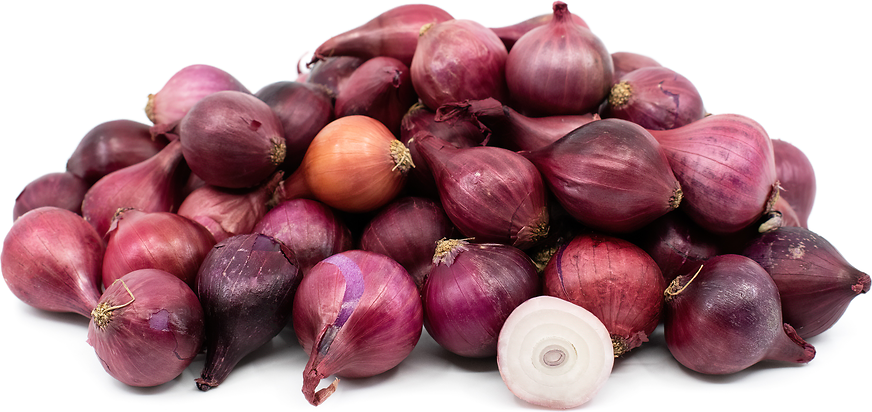


Red Pearl Onions
Estimated Inventory, 12 ct : 1.92
This item was last sold on : 05/04/25
Description/Taste
Red Pearl onions are small in size, averaging 1-4 centimeters in diameter, and are globular in shape with slightly pointed ends. The petite bulb is covered in a burgundy, thin, papery, parchment that easily flakes off when touched. Underneath the skin, there is a purple sheath, similar to garlic, and the flesh is light purple-white, almost translucent with layers of thin rings. The flesh is firm, juicy, and crisp. Red Pearl onions are crunchy, sweet, and mildly pungent when fresh and when cooked, they develop a savory, sweet, and slightly less pungent flavor than full-sized onions.
Seasons/Availability
Red Pearl onions are available year-round.
Current Facts
Red Pearl onions, botanically classified as Allium cepa, are tiny, young onions that are members of the Amaryllidaceae family. Also known as Cocktail onions, Picklers, Baby onions, and Button onions, Red Pearl onions are a long-day storage variety that gets their size by being planted in dense clusters to inhibit growth, are harvested early, approximately ninety days after planting, or are planted in environments that may stunt growth due to sunlight and temperature conditions. Red Pearl onions are slightly smaller than boiler onions and are favored for their sweet, mild nature. They will not overpower dishes and can be used in a variety of culinary applications including fresh preparations.
Nutritional Value
Red Pearl onions contain antioxidants, flavonoids, fiber, vitamin C, vitamin A, calcium, and potassium.
Applications
Red Pearl onions are best suited for both raw and cooked applications such as grilling, roasting, and pickling. The small bulbs are most commonly used whole, and the skins can be peeled by boiling for two minutes, dropping in ice water, cutting off the ends, and then pinching the flesh out from under the skin. Red Pearl onions can be incorporated fresh into salads, beans, and grain bowls. They can also be cooked in braises, grilled on skewers, glazed in lime or balsamic sauce, creamed with bacon, or added to roasted meats and vegetables. When pickled, Red Pearl onions can be added to salads, garnished on cocktails, or served on appetizer plates. They can also be skewered with meat and vegetables and grilled for a smoky, caramelized finish. Red Pearl onions pair well with meats such as pork, poultry, turkey, veal, steak, and white fish, béchamel sauce, cream-based sauces, red wine, light bodied vinegars, goat, cheddar, aged sheep’s cheese, paprika, parsley, basil, Dijon mustard, potatoes, green beans, peas, turnips, tomatoes, and apples. The bulbs will keep 1-2 months when stored in a cool, dry, and dark place with good air circulation. If sliced, the remaining pieces will keep up to four days when wrapped in plastic and stored in the refrigerator.
Ethnic/Cultural Info
Red Pearl onions are favored for pickling as their bright red hue, and small size makes it suitable for bite-size portions. Pickling vegetables have been practiced for thousands of years in many different cultures across the world. A technique used to preserve and prolong shelf life, pickled vegetables provided food for long land journeys, during the winter season, and for sailing voyages. Red Pearl onions are popularly pickled and used as a garnish on cocktails and appetizer plates as they remain slightly crunchy when soaked in brine.
Geography/History
Onions are native to Asia and have been cultivated since ancient times. While the exact date of when Red Pearl onions were cultivated for their small size is unknown, today the onions are widespread and are available at farmers markets, specialty grocers, and supermarkets in North America, Europe, Asia, and Australia.
Featured Restaurants
Restaurants currently purchasing this product as an ingredient for their menu.
| Yoann Taboyan, Personal Chef | San Diego CA | 347-277-1958 |
| Residence Inn Downtown Gaslamp | San Diego CA | 619-487-1200 |
| Portside Pier (TopSail) | San Diego CA | 858-268-1030 |
| Jeune Et Jolie | Carlsbad CA | 858-231-0862 |
| Mission Pacific | Oceanside CA | 760-450-7864 |
| Kettner Exchange | San Diego CA | 909-915-9877 |
| Wormwood | San Diego CA | 619-573-0289 |
| Javier Plascencia (Animalon) | Bonita CA | 619-295-3172 |
| Waverly | Cardiff CA | 619-244-0416 |
Recipe Ideas
Recipes that include Red Pearl Onions. One










